Home > Directory Home > Drawing Lessons > Drawing for Beginners >How to Draw Your Pets and Other Animals Tutorials for Kids
Drawing your pets and animals : How to Draw animals and birds
|
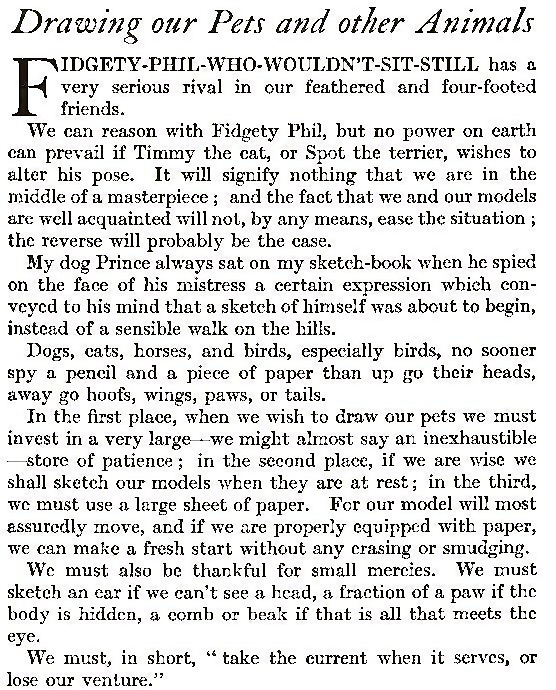
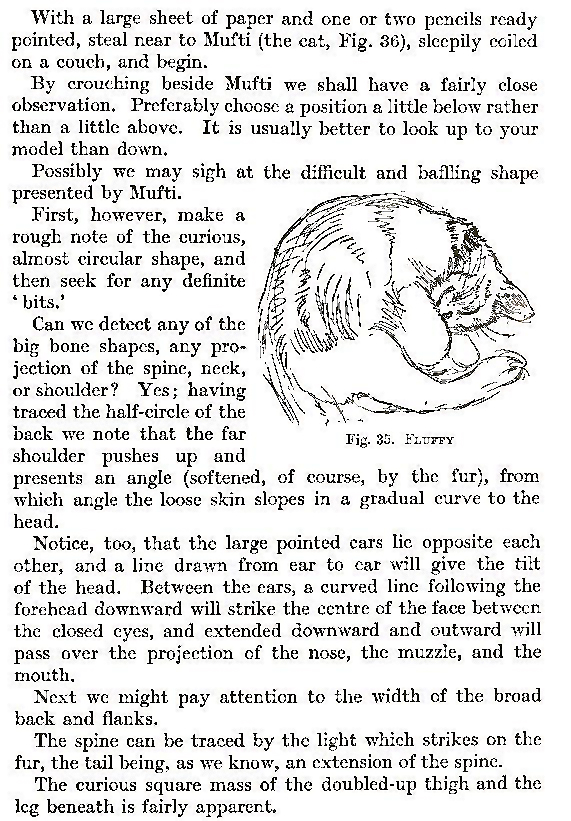
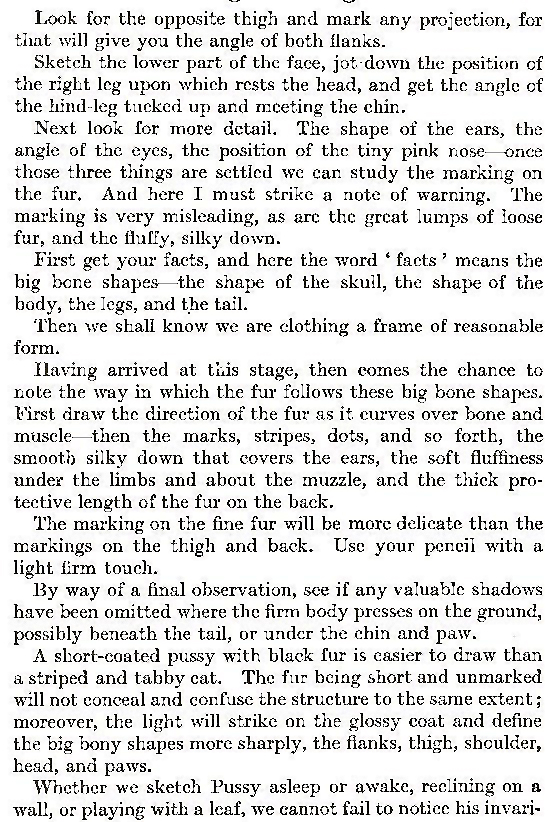
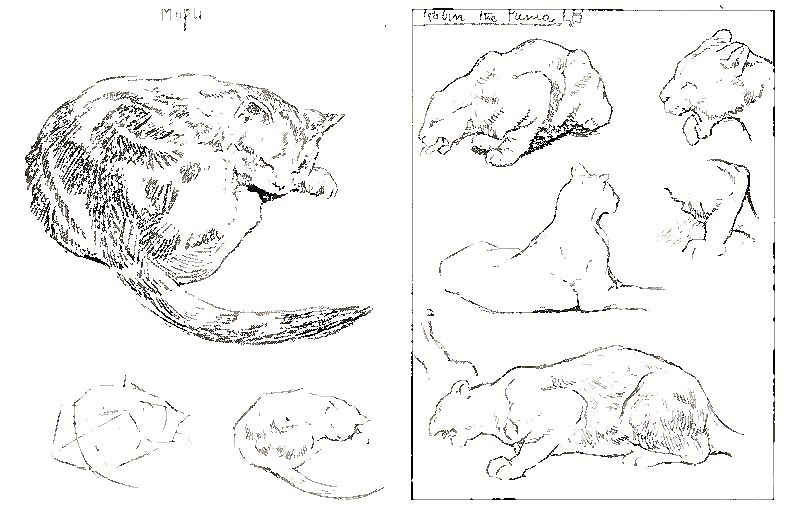
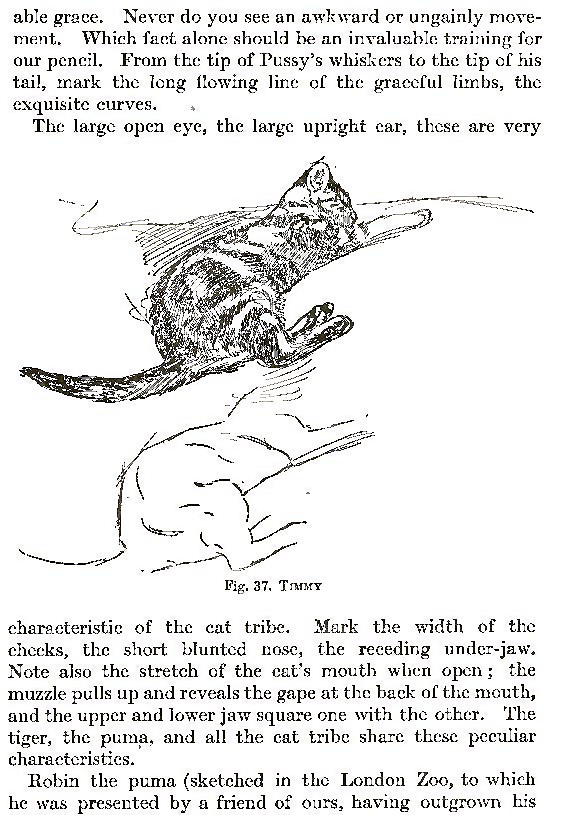
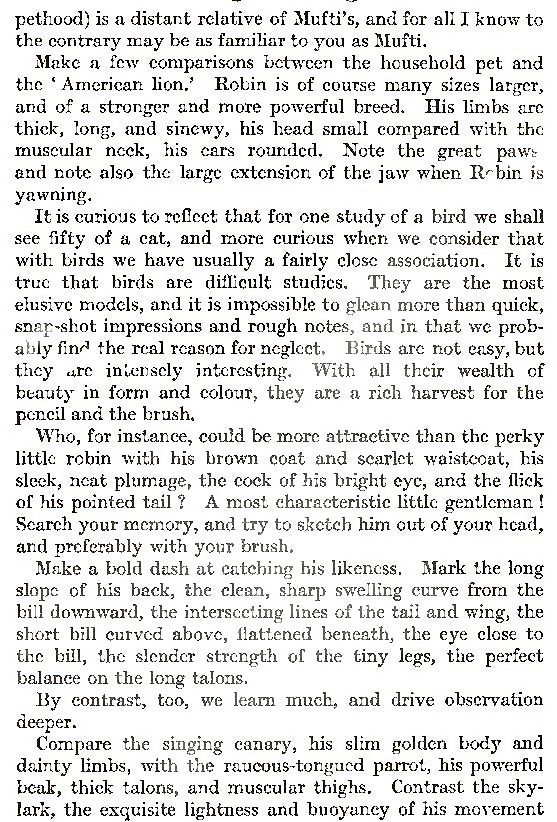
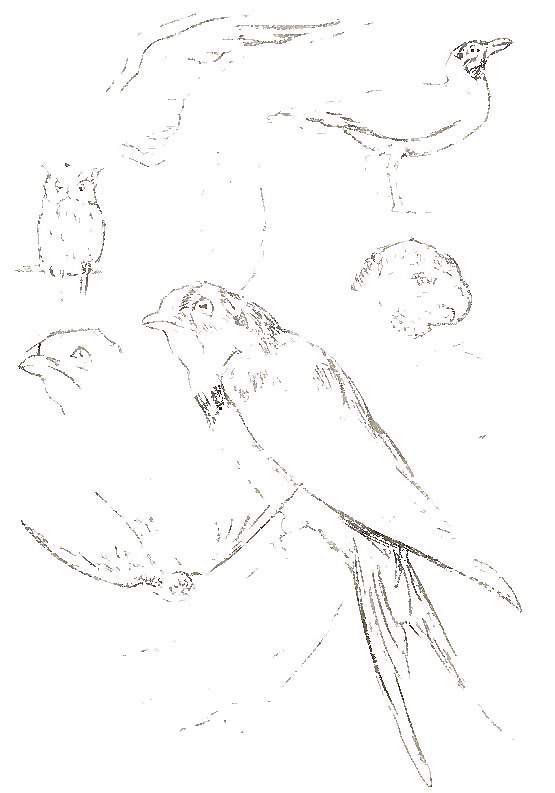
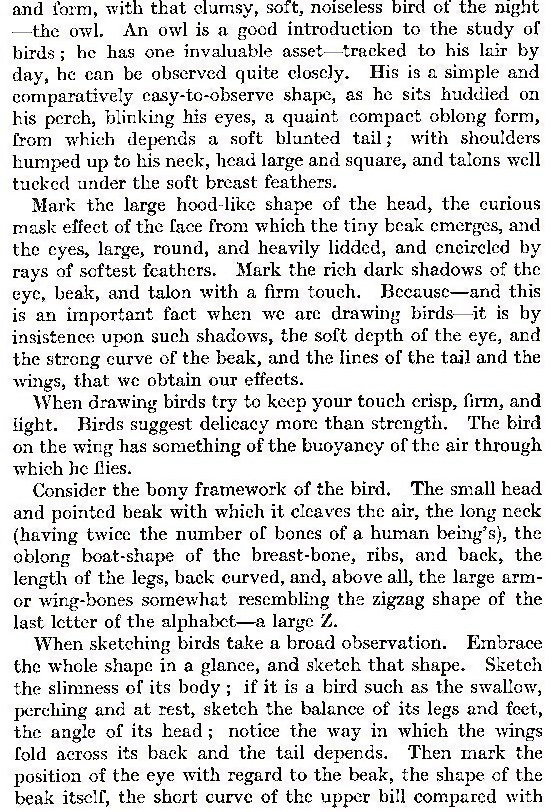
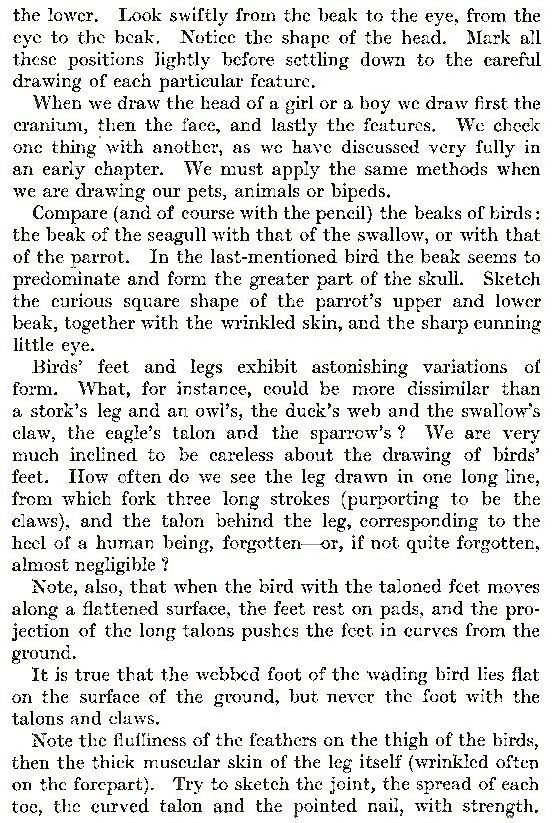
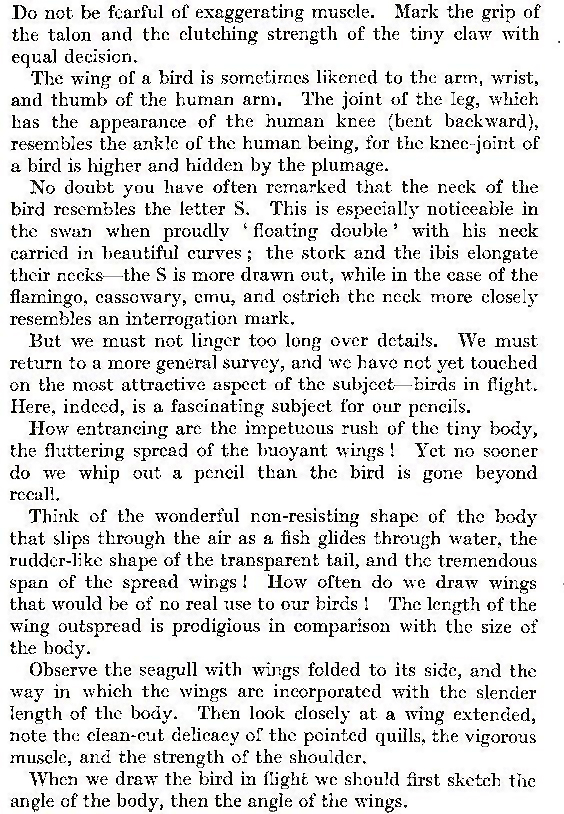
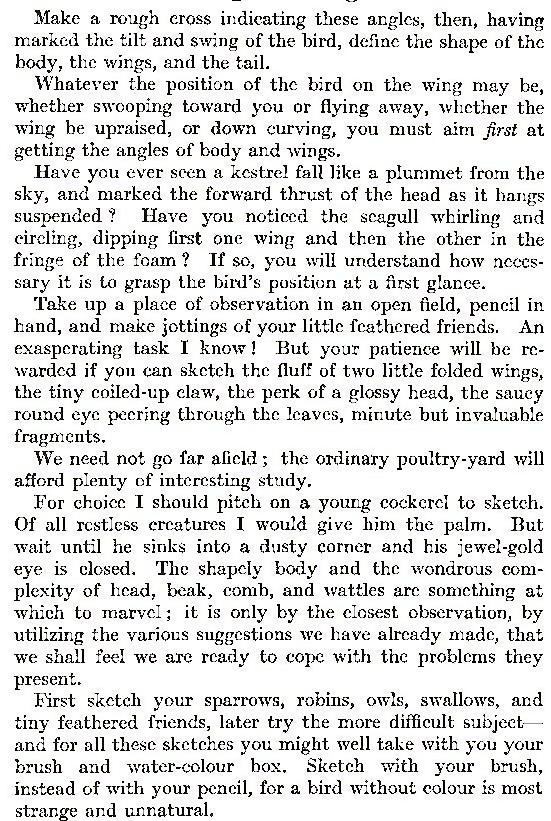
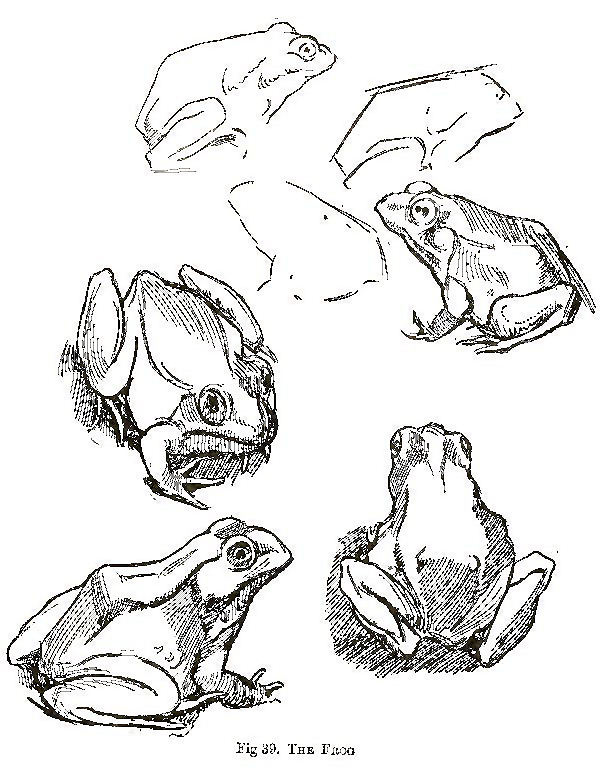
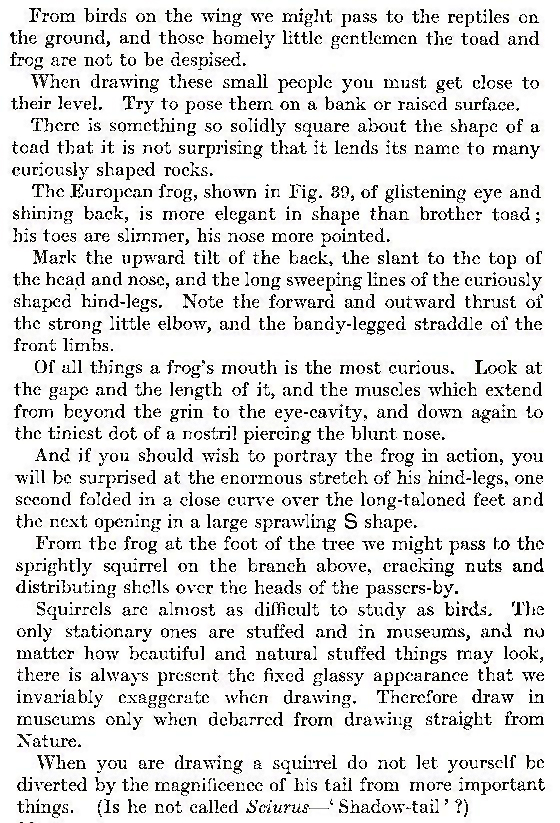
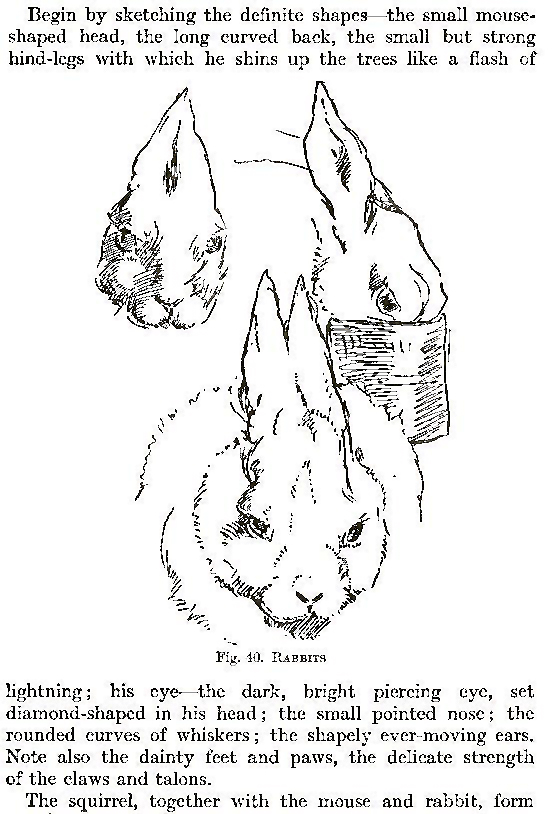
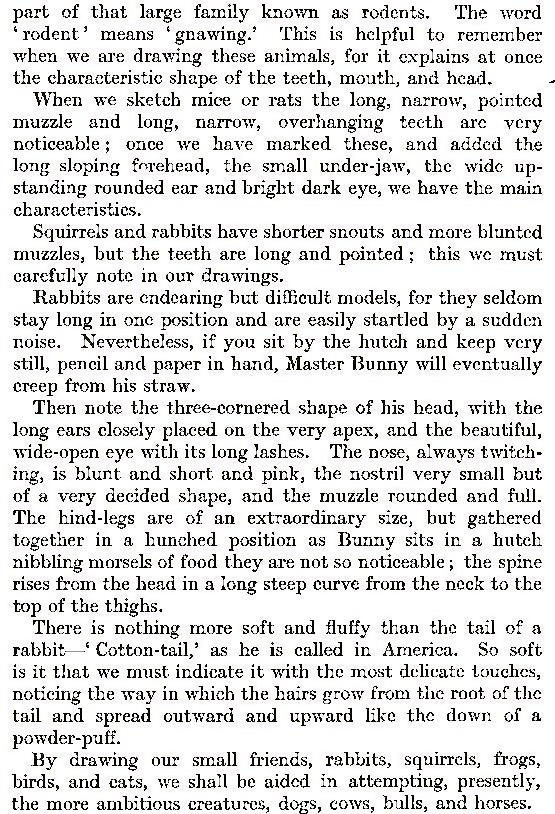
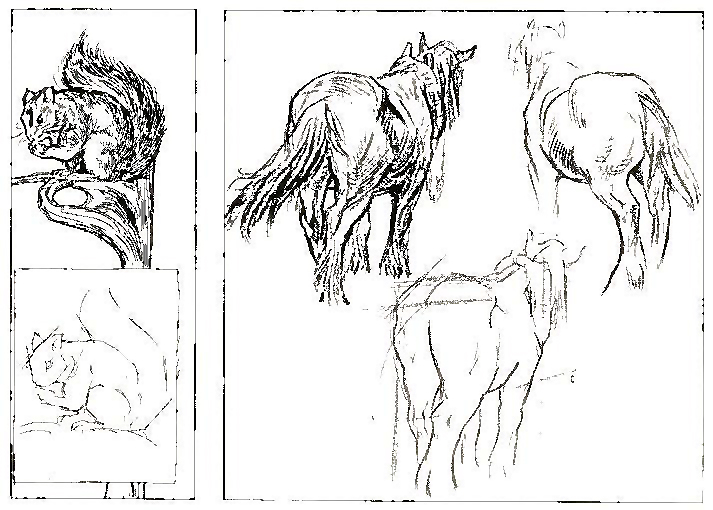
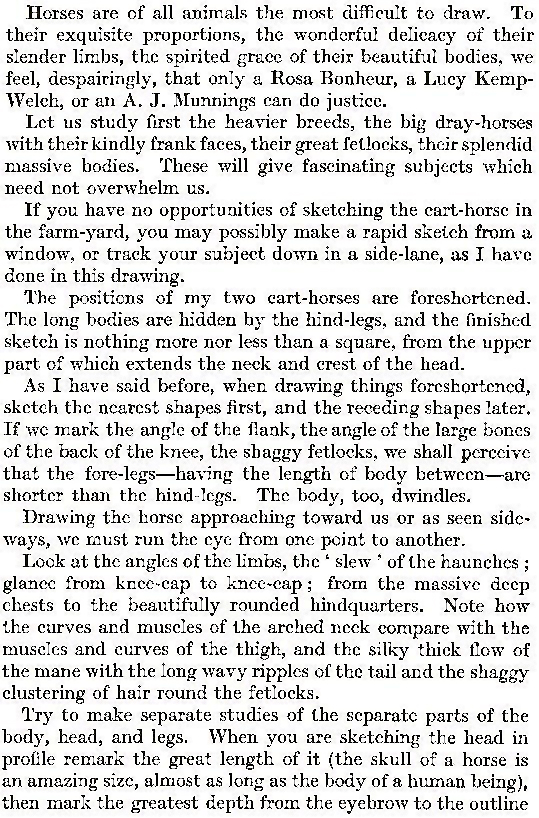
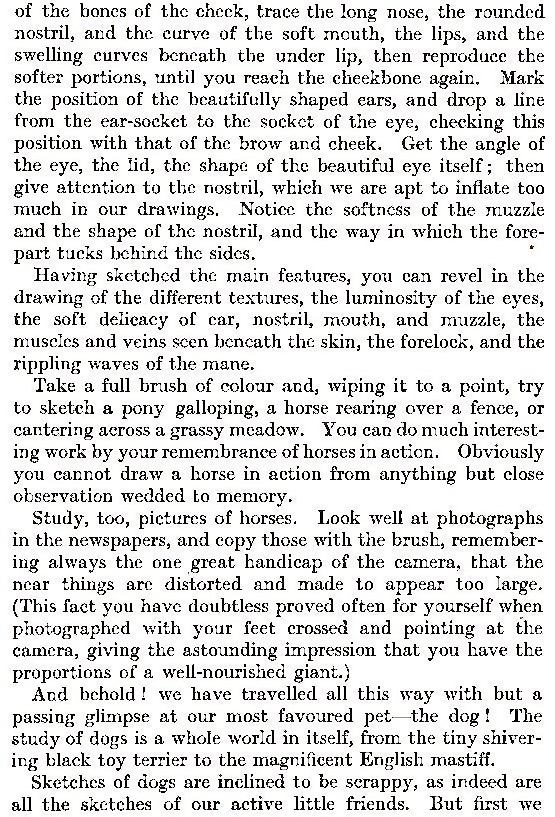
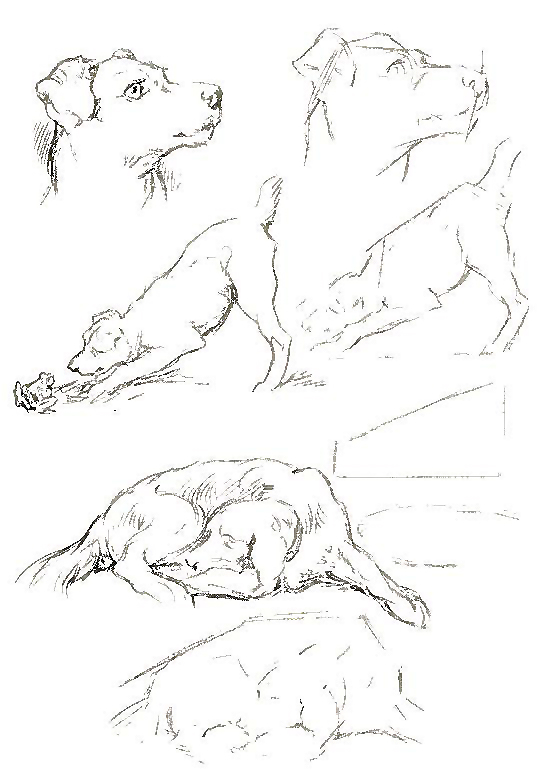
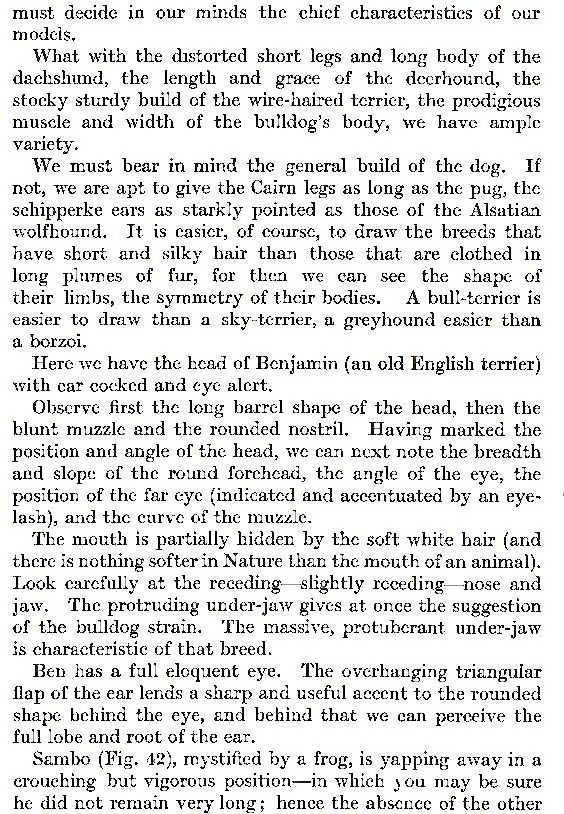
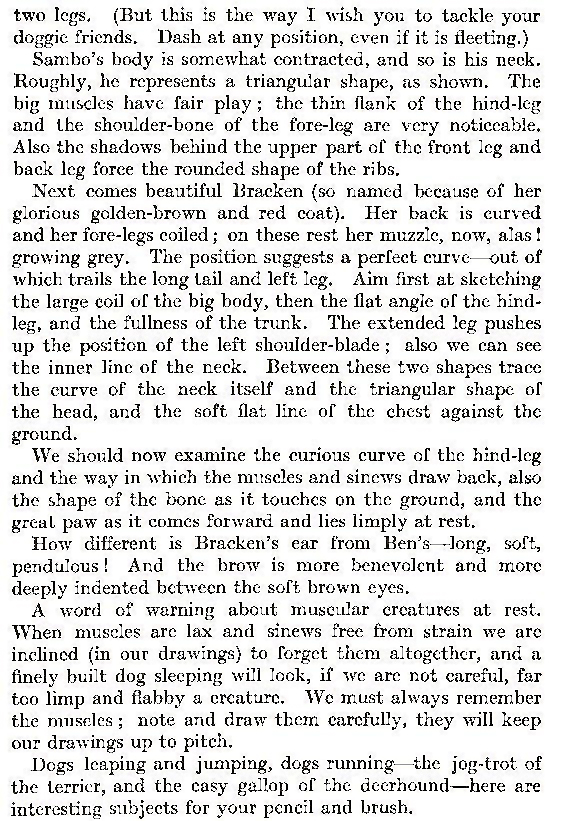

GO BACK TO THE HOME PAGE FOR TUTORIALS FOR BEGINNING ARTISTS
[The above words are pictures of text, below is the actual text if you need to copy a paragraph or two]
Drawing our Pets and other Animals
FIDGETY-PHIL-WHO-WOULDN'T-SIT-STILL has a very serious rival in our feathered and four-footed friends.
We can reason with Fidgety Phil, but no power on earth can prevail if Timmy the cat, or Spot the terrier, wishes to alter his pose. It will signify nothing that we are in the middle of a masterpiece ; and the fact that we and our models are well acquainted will not, by any means, ease the situation ; the reverse will probably be the case.
My dog Prince always sat on my sketch-book when he spied on the face of his mistress a certain expression which conveyed to his mind that a sketch of himself was about to begin, instead of a sensible walk on the hills.
Dogs, cats, horses, and birds, especially birds, no sooner spy a pencil and a piece of paper than up go their heads, away go hoofs, wings, paws, or tails.
In the first place, when we wish to draw our pets we must invest in a very large—we might almost say an inexhaustible —store of patience ; in the second place, if we are wise we shall sketch our models when they are at rest ; in the third, we must use a large sheet of paper. For our model will most assuredly move, and if we are properly equipped with paper, we can make a fresh start without any erasing or smudging.
We must also be thankful for small mercies. We must sketch an ear if we can't see a head, a fraction of a paw if the body is hidden, a comb or beak if that is all that meets the eye.
We must, in short, " take the current when it serves, or lose our venture."
With a large sheet of paper and one or two pencils ready pointed, steal near to Mufti (the cat, Fig. 36), sleepily coiled on a couch, and begin.
By crouching beside Mufti we shall have a fairly close observation. Preferably choose a position a little below rather than a little above. It is usually better to look up to your model than down.
Possibly we may sigh at the difficult and baffling shape presented by Mufti.
First, however, make a rough note of the curious, almost circular shape, and then seek for any definite ' bits.'
Can we detect any of the big bone shapes, any projection of the spine, neck, or shoulder? Yes; having traced the half-circle of the back we note that the far shoulder pushes up and presents an angle (softened, of course, by the fur), from which angle the loose skin slopes in a gradual curve to the head.
Notice, too, that the large pointed cars lie opposite each other, and a line drawn from ear to ear will give the tilt of the
head. Between the ears, a curved line following the forehead downward will strike the centre of the face between the closed eyes, and extended downward and outward will pass over the projection of the nose, the muzzle, and the mouth.
Next we might pay attention to the width of the broad back and flanks.
The spine can be traced by the light which strikes on the fur, the tail being, as we know, an extension of the spine.
The curious square mass of the doubled-up thigh and the leg beneath is fairly apparent.
Look for the opposite thigh and mark any projection, for that will give you the angle of both flanks.
Sketch the lower part of the face, jot down the position of the right leg upon which rests the head, and get the angle of the hind-leg tucked up and meeting the chin.
Next look for more detail. The shape of the ears, the angle of the eyes, the position of the tiny pink nose—once those three things are settled we can study the marking on the fur. And here I must strike a note of warning. The marking is very misleading, as are the great lumps of loose fur, and the fluffy, silky down.
First get your facts, and here the word facts ' means the big bone shapes—the shape of the skull, the shape of the body, the legs, and the tail.
Then we shall know we are clothing a frame of reasonable form.
Having arrived at this stage, then comes the chance to note the way in which the fur follows these big bone shapes. First draw the direction of the fur as it curves over bone and muscle—then the marks, stripes, dots, and so forth, the smooth silky down that covers the ears, the soft fluffiness under the limbs and about the muzzle, and the thick protective length of the fur on the back.
The marking on the fine fur will be more delicate than the markings on the thigh and back. Use your pencil with a light firm touch.
By way of a final observation, see if any valuable shadows have been omitted where the firm body presses on the ground, possibly beneath the tail, or under the chin and paw.
A short-coated pussy with black fur is easier to draw than a striped and tabby cat. The fur being short and unmarked will not conceal and confuse the structure to the same extent ; moreover, the light will strike on the glossy coat and define the big bony shapes more sharply, the flanks, thigh, shoulder, head, and paws.
Whether we sketch Pussy asleep or awake, reclining on a wall, or playing with a leaf, we cannot fail to notice his invariable grace. Never do you see an awkward or ungainly movement. Which fact alone should be an invaluable training for our pencil.
From the tip of Pussy's whiskers to the tip of his tail, mark the long flowing line of the graceful limbs, the exquisite curves.
The large open eye, the large upright ear, these are very characteristic of the cat tribe. Mark the width of the cheeks, the short blunted nose, the receding under-jaw. Note also the stretch of the cat's mouth when open ; the muzzle pulls up and reveals the gape at the back of the mouth, and the upper and lower jaw square one with the other. The tiger, the pump,, and all the cat tribe share these peculiar characteristics.
Robin the puma (sketched in the London Zoo, to which he was presented by a friend of ours, having outgrown his pethood) is a distant relative of Mufti's, and for all I know to the contrary may be as familiar to you as Mufti.
Make a few comparisons between the household pet and the ' American lion.' Robin is of course many sizes larger, and of a stronger and more powerful breed. His limbs are thick, long, and sinewy, his head small compared with the muscular neck, his ears rounded. Note the great paw, and note also the large extension of the jaw when Robin is yawning.
It is curious to reflect that for one study of a bird we shall see fifty of a cat, and more curious when we consider that with birds we have usually a fairly close association. It is true that birds are difficult studies. They are the most elusive models, and it is impossible to glean more than quick, snap-shot impressions and rough notes, and in that we probably fins' the real reason for neglect. Birds are not easy, but they are intensely interesting. With all their wealth of beauty in form and colour, they are a rich harvest for the pencil and the brush.
Who, for instance, could be more attractive than the perky little robin with his brown coat and scarlet waistcoat, his sleek, neat plumage, the cock of his bright eye, and the flick of his pointed tail ? A most characteristic little gentleman ! Search your memory, and try to sketch him out of your head, and preferably with your brush.
Make a bold dash at catching his likeness. Mark the long slope of his back, the clean, sharp swelling curve from the bill downward, the intersecting lines of the tail and wing, the short bill curved above, flattened beneath, the eye close to the bill, the slender strength of the tiny legs, the perfect balance on the long talons.
By contrast, too, we learn much, and drive observation deeper.
Compare the singing canary, his slim golden body and dainty limbs, with the raucous-tongued parrot, his powerful beak, thick talons, and muscular thighs. Contrast the skylark, the exquisite lightness and buoyancy of his movement and form, with that clumsy, soft, noiseless bird of the night —the owl. An owl is a good introduction to the study of birds; he has one invaluable asset—tracked to his lair by day, he can be observed quite closely. His is a simple and comparatively easy-to-observe shape, as he sits huddled on his perch, blinking his eyes, a quaint compact oblong form, from which depends a soft blunted tail ; with shoulders humped up to his neck, head large and square, and talons well tucked under the soft breast feathers.
Mark the large hood-like shape of the head, the curious mask effect of the face from which the tiny beak emerges, and the eyes, large, round, and heavily lidded, and encircled by rays of softest feathers. Mark the rich dark shadows of the eye, beak, and talon with a firm touch. Because—and this is an important fact when we are drawing birds—it is by insistence upon such shadows, the soft depth of the eye, and the strong curve of the beak, and the lines of the tail and the wings, that we obtain our effects.
When drawing birds try to keep your touch crisp, firm, and light. Birds suggest delicacy more than strength. The bird on the wing has something of the buoyancy of the air through which he flies.
Consider the bony framework of the bird. The small head and pointed beak with which it cleaves the air, the long neck (having twice the number of bones of a human being's), the oblong boat-shape of the breast-bone, ribs, and back, the length of the legs, back curved, and, above all, the large armor wing-bones somewhat resembling the zigzag shape of the last letter of the alphabet—a large Z.
When sketching birds take a broad observation. Embrace the whole shape in a glance, and sketch that shape. Sketch the slimness of its body ; if it is a bird such as the swallow, perching and at rest, sketch the balance of its legs and feet, the angle of its head ; notice the way in which the wings fold across its back and the tail depends. Then mark the position of the eye with regard to the beak, the shape of the beak itself, the short curve of the upper bill compared with the lower. Look swiftly from the beak to the eye, from the eye to the beak. Notice the shape of the head. Mark all these positions lightly before settling down to the careful drawing of each particular feature.
When we draw the head of a girl or a boy we draw first the cranium, then the face, and lastly the features. We check one thing with another, as we have discussed very fully in an early chapter. We must apply the same methods when we are drawing our pets, animals or bipeds.
Compare (and of course with the pencil) the beaks of birds : the beak of the seagull with that of the swallow, or with that of the parrot. In the last-mentioned bird the beak seems to predominate and form the greater part of the skull. Sketch the curious square shape of the parrot's upper and lower beak, together with the wrinkled skin, and the sharp cunning little eye.
Birds' feet and legs exhibit astonishing variations of form. What, for instance, could be more dissimilar than a stork's leg and an owl's, the duck's web and the swallow's claw, the eagle's talon and the sparrow's ? We are very much inclined to be careless about the drawing of birds' feet. How often do we see the leg drawn in one long line, from which fork three long strokes (purporting to be the claws), and the talon behind the leg, corresponding to the heel of a human being, forgotten—or, if not quite forgotten, almost negligible?
Note, also, that when the bird with the taloned feet moves along a flattened surface, the feet rest on pads, and the projection of the long talons pushes the feet in curves from the ground.
It is true that the webbed foot of the wading bird lies flat on the surface of the ground, but never the foot with the talons and claws.
Note the fluffiness of the feathers on the thigh of the birds, then the thick muscular skin of the leg itself (wrinkled often on the forepart). Try to sketch the joint, the spread of each toe, the curved talon and the pointed nail, with strength.
Do not be fearful of exaggerating muscle. Mark the grip of the talon and the clutching strength of the tiny claw with equal decision.
The wing of a bird is sometimes likened to the arm, wrist, and thumb of the human arm. The joint of the leg, which has the appearance of the human knee (bent backward), resembles the ankle of the human being, for the knee-joint of a bird is higher and hidden by the plumage.
No doubt you have often remarked that the neck of the bird resembles the letter S. This is especially noticeable in the swan when proudly ' floating double ' with his neck carried in beautiful curves ; the stork and the ibis elongate their necks—the S is more drawn out, while in the case of the flamingo, cassowary, emu, and ostrich the neck more closely resembles an interrogation mark.
But we must not linger too long over details. We must return to a more general survey, and we have not yet touched on the most attractive aspect of the subject—birds in flight. Here, indeed, is a fascinating subject for our pencils.
How entrancing are the impetuous rush of the tiny body, the fluttering spread of the buoyant wings ! Yet no sooner do we whip out a pencil than the bird is gone beyond recall.
Think of the wonderful non-resisting shape of the body that slips through the air as a fish glides through water, the rudder-like shape of the transparent tail, and the tremendous span of the spread wings ! How often do we draw wings that would be of no real use to our birds ! The length of the wing outspread is prodigious in comparison with the size of the body.
Observe the seagull with wings folded to its side, and the way in which the wings are incorporated with the slender length of the body. Then look closely at a wing extended, note the clean-cut delicacy of the pointed quills, the vigorous muscle, and the strength of the shoulder.
When we draw the bird in flight we should first sketch the angle of the body, then the angle of the wings.
Make a rough cross indicating these angles, then, having marked the tilt and swing of the bird, define the shape of the body, the wings, and the tail.
Whatever the position of the bird on the wing may be, whether swooping toward you or flying away, whether the wing be upraised, or down curving, you must aim first at getting the angles of body and wings.
Have you ever seen a kestrel fall like a plummet from the sky, and marked the forward thrust of the head as it hangs suspended?
Have you noticed the seagull whirling and circling, dipping first one wing and then the other in the fringe of the foam ? If so, you will understand how necessary it is to grasp the bird's position at a first glance.
Take up a place of observation in an open field, pencil in hand, and make jottings of your little feathered friends. An exasperating task I know ! But your patience will be rewarded if you can sketch the fluff of two little folded wings, the tiny coiled-up claw, the perk of a glossy head, the saucy round eye peering through the leaves, minute but invaluable fragments.
We need not go far afield ; the ordinary poultry-yard will afford plenty of interesting study.
For choice I should pitch on a young cockerel to sketch. Of all restless creatures I would give him the palm. But wait until he sinks into a dusty corner and his jewel-gold eye is closed. The shapely body and the wondrous complexity of head, beak, comb, and wattles are something at which to marvel ; it is only by the closest observation, by utilizing the various suggestions we have already made, that we shall feel we are ready to cope with the problems they present.
First sketch your sparrows, robins, owls, swallows, and tiny feathered friends, later try the more difficult subject—and for all these sketches you might well take with you your brush and water-colour box. Sketch with your brush, instead of with your pencil, for a bird without colour is most strange and unnatural.
Fig 39. THE FROG
From birds on the wing we might pass to the reptiles on the ground, and those homely little gentlemen the toad and frog are not to be despised.
When drawing these small people you must get close to their level. Try to pose them on a bank or raised surface.
There is something so solidly square about the shape of a toad that it is not surprising that it lends its name to many curiously shaped rocks.
The European frog, shown in Fig. 39, of glistening eye and shining back, is more elegant in shape than brother toad ; his toes are slimmer, his nose more pointed.
Mark the upward tilt of the back, the slant to the top of the head and nose, and the long sweeping lines of the curiously shaped hind-legs. Note the forward and outward thrust of the strong little elbow, and the bandy-legged straddle of the front limbs.
Of all things a frog's mouth is the most curious. Look at the gape and the length of it, and the muscles which extend from beyond the grin to the eye-cavity, and down again to the tiniest dot of a nostril piercing the blunt nose.
And if you should wish to portray the frog in action, you will be surprised at the enormous stretch of his hind-legs, one second folded in a close curve over the long-taloned feet and the next opening in a large sprawling S shape.
From the frog at the foot of the tree we might pass 1-,o the sprightly squirrel on the branch above, cracking nuts and distributing shells over the heads of the passers-by.
Squirrels are almost as difficult to study as birds. The only stationary ones are stuffed and in museums, and no matter how beautiful and natural stuffed things may look, there is always present the fixed glassy appearance that we invariably exaggerate when drawing. Therefore draw in museums only when debarred from drawing straight from Nature.
When you are drawing a squirrel do not let yourself be diverted by the magnificence of his tail from more important things. (Is he not called Sciurus—` Shadow-tail' ?) part of that large family known as rodents. The word rodent' means gnawing.' This is helpful to remember when we are drawing these animals, for it explains at once the characteristic shape of the teeth, mouth, and head.
When we sketch mice or rats the long, narrow, pointed muzzle and long, narrow, overhanging teeth are very noticeable ; once we have marked these, and added the long sloping forehead, the small under-jaw, the wide upstanding rounded ear and bright dark eye, we have the main characteristics.
Squirrels and rabbits have shorter snouts and more blunted muzzles, but the teeth are long and pointed ; this we must carefully note in our drawings.
Rabbits are endearing but difficult models, for they seldom stay long in one position and are easily startled by a sudden noise.
Nevertheless, if you sit by the hutch and keep very still, pencil and paper in hand, Master Bunny will eventually creep from his straw.
Then note the three-cornered shape of his head, with the long ears closely placed on the very apex, and the beautiful, wide-open eye with its long lashes. The nose, always twitching, is blunt and short and pink, the nostril very small but of a very decided shape, and the muzzle rounded and full. The hind-legs are of an extraordinary size, but gathered together in a hunched position as Bunny sits in a hutch nibbling morsels of food they are not so noticeable ; the spine rises from the head in a long steep curve from the neck to the top of the thighs.
There is nothing more soft and fluffy than the tail of a rabbit—' Cotton-tail,' as he is called in America. So soft is it that we must indicate it with the most delicate touches, noticing the way in which the hairs grow from the root of the tail and spread outward and upward like the down of a powder-puff.
By drawing our small friends, rabbits, squirrels, frogs, birds, and cats, we shall be aided in attempting, presently, the more ambitious creatures, dogs, cows, bulls, and horses.
Horses are of all animals the most difficult to draw. To their exquisite proportions, the wonderful delicacy of their slender limbs, the spirited grace of their beautiful bodies, we feel, despairingly, that only a Rosa Bonheur, a Lucy Kemp-Welch, or an A. J. Munnings can do justice.
Let us study first the heavier breeds, the big dray-horses with their kindly frank faces, their great fetlocks, their splendid massive bodies. These will give fascinating subjects which need not overwhelm us.
If you have no opportunities of sketching the cart-horse in the farm-yard, you may possibly make a rapid sketch from a window, or track your subject down in a side-lane, as I have done in this drawing.
The positions of my two cart-horses are foreshortened. The long bodies are hidden by the hind-legs, and the finished sketch is nothing more nor less than a square, from the upper part of which extends the neck and crest of the head.
As I have said before, when drawing things foreshortened, sketch the nearest shapes first, and the receding shapes later. If we mark the angle of the flank, the angle of the large bones of the back of the knee, the shaggy fetlocks, we shall perceive that the fore-legs—having the length of body between—are shorter than the hind-legs. The body, too, dwindles.
Drawing the horse approaching toward us or as seen sideways, we must run the eye from one point to another.
Look at the angles of the limbs, the slew ' of the haunches ; glance from knee-cap to knee-cap ; from the massive deep chests to the beautifully rounded hindquarters. Note how the curves and muscles of the arched neck compare with the muscles and curves of the thigh, and the silky thick flow of the mane with the long wavy ripples of the tail and the shaggy clustering of hair round the fetlocks.
Try to make separate studies of the separate parts of the body, head, and legs. When you are sketching the head in profile remark the great length of it (the skull of a horse is an amazing size, almost as long as the body of a human being), then mark the greatest depth from the eyebrow to the outline of the bones of the cheek, trace the long nose, the rounded nostril, and the curve of the soft mouth, the lips, and the swelling curves beneath the under lip, then reproduce the softer portions, until you reach the cheekbone again. Mark the position of the beautifully shaped ears, and drop a line from the ear-socket to the socket of the eye, checking this position with that of the brow and cheek. Get the angle of the eye, the lid, the shape of the beautiful eye itself ; then give attention to the nostril, which we are apt to inflate too much in our drawings. Notice the softness of the muzzle and the shape of the nostril, and the way in which the forepart tucks behind the sides.
Having sketched the main features, you can revel in the drawing of the different textures, the luminosity of the eyes, the soft delicacy of ear, nostril, mouth, and muzzle, the muscles and veins seen beneath the skin, the forelock, and the rippling waves of the mane.
Take a full brush of colour and, wiping it to a point, try to sketch a pony galloping, a horse rearing over a fence, or cantering across a grassy meadow. You can do much interesting work by your remembrance of horses in action. Obviously you cannot draw a horse in action from anything but close observation wedded to memory.
Study, too, pictures of horses. Look well at photographs in the newspapers, and copy those with the brush, remembering always the one great handicap of the camera, that the near things arc distorted and made to appear too large. (This fact you have doubtless proved often for yourself when photographed with your feet crossed and pointing at the camera, giving the astounding impression that you have the proportions of a well-nourished giant.)
And behold ! we have travelled all this way with but a passing glimpse at our most favoured pet—the dog ! The study of dogs is a whole world in itself, from the tiny shivering black toy terrier to the magnificent English mastiff.
Sketches of dogs are inclined to be scrappy, as indeed are all the sketches of our active little friends. But first we must decide in our minds the chief characteristics of our models.
What with the distorted short legs and long body of the dachshund, the length and grace of the deerhound, the stocky sturdy build of the wire-haired terrier, the prodigious muscle and width of the bulldog's body, we have ample variety.
We must bear in mind the general build of the dog. If not, we are apt to give the Cairn legs as long as the pug, the schipperke ears as starkly pointed as those of the Alsatian wolfhound. It is easier, of course, to draw the breeds that have short and silky hair than those that are clothed in long plumes of fur, for then we can see the shape of their limbs, the symmetry of their bodies. A bull-terrier is easier to draw than a sky-terrier, a greyhound easier than a borzoi.
Here we have the head of Benjamin (an old English terrier) with ear cocked and eye alert.
Observe first the long barrel shape of the head, then the blunt muzzle and the rounded nostril. Having marked the position and angle of the head, we can next note the breadth and slope of the round forehead, the angle of the eye, the position of the far eye (indicated and accentuated by an eyelash), and the curve of the muzzle.
The mouth is partially hidden by the soft white hair (and there is nothing softer in Nature than the mouth of an animal). Look carefully at the receding—slightly receding—nose and jaw. The protruding under-jaw gives at once the suggestion of the bulldog strain. The massive, protuberant under-jaw is characteristic of that breed.
Ben has a full eloquent eye. The overhanging triangular flap of the ear lends a sharp and useful accent to the rounded shape behind the eye, and behind that we can perceive the full lobe and root of the ear.
Sambo (Fig. 42), mystified by a frog, is yapping away in a crouching but vigorous position—in which 3, ou may be sure he did not remain very long ; hence the absence of the other two legs. (But this is the way I wish you to tackle your doggie friends. Dash at any position, even if it is fleeting.)
Sambo's body is somewhat contracted, and so is his neck. Roughly, he represents a triangular shape, as shown. The big muscles have fair play ; the thin flank of the hind-leg and the shoulder-bone of the fore-leg are very noticeable. Also the shadows behind the upper part of the front leg and back leg force the rounded shape of the ribs.
Next comes beautiful Bracken (so named because of her glorious golden-brown and red coat). Her back is curved and her fore-legs coiled ; on these rest her muzzle, now, alas ! growing grey. The position suggests a perfect curve—out of which trails the long tail and left leg. Aim first at sketching the large coil of the big body, then the flat angle of the hind-leg, and the fullness of the trunk. The extended leg pushes up the position of the left shoulder-blade ; also we can see the inner line of the neck.
Between these two shapes trace the curve of the neck itself and the triangular shape of the head, and the soft flat line of the chest against the ground.
We should now examine the curious curve of the hind-leg and the way in which the muscles and sinews draw back, also the shape of the bone as it touches on the ground, and the great paw as it comes forward and lies limply at rest.
How different is Bracken's ear from Ben's—long, soft, pendulous ! And the brow is more benevolent and more deeply indented between the soft brown eyes.
A word of warning about muscular creatures at rest. When muscles are lax and sinews free from strain we are inclined (in our drawings) to forget them altogether, and a finely built dog sleeping will look, if we are not careful, far too limp and flabby a creature. We must always remember the muscles ; note and draw them carefully, they will keep our drawings up to pitch.
Dogs leaping and jumping, dogs running—the jog-trot of the terrier, and the easy gallop of the deerhound—here are interesting subjects for your pencil and brush.
We might take up a brush fairly full of paint and sketch a little fresco of dogs in action. I say advisedly ' brush.' VVe can't stipple with a full brush. We must make up our minds, and draw, without hesitation, the thin or plump body, the long or thick legs, the short or pointed nose, the flowing or stunted tail. The fresco may not be very true to Nature, but it will certainly teach us a good deal.
Privacy Policy ..... Contact Us




